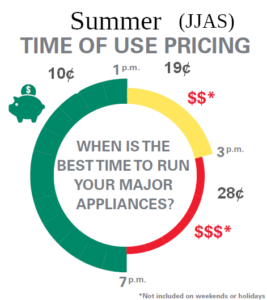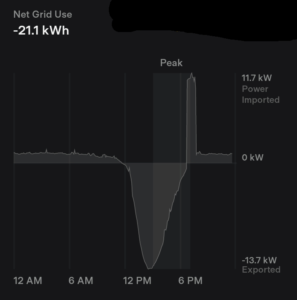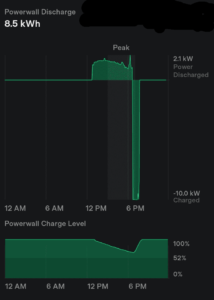
There are many states, including Colorado, where the electric company has worked it out with the state regulator to be able to charge for electricity based upon the time of day. In Colorado, the cheap time is from 7 PM to 1PM Monday through Friday, and cheap time also happens all day Saturday and Sunday and some holidays. If one has battery storage, this is an opportunity to engage in some arbitrage.
There are two things going on here — money on the one hand, and public policy on the other.
From the money point of view, it is of course clear that the customer who wants to save money should avoid purchasing electricity during the expensive times — 1PM to 7PM Monday through Friday. Not only that, but it would also be advantageous to sell electricity to the electric company during those times, especially between 3PM and 7PM when the electric company is required to pay 28¢ for each kilowatt-hour.
We can then turn to public policy. The electric company says that its reason for wanting to charge more during the yellow and red times is that if it must fire up a “peak” power generation device during peak time, this is probably a dirtier source of power.
So in fact if the customer sells electricity to the electric company during a peak time, this is in fact helping to reduce pollution by denying the electric company the need to generate that electricity using a dirty source.
With this background in mind, what can the customer do to try to save money on electric bills, and to try to reduce pollution? The answer is simple. Configure the battery storage system so that the customer never purchases electricity from the electric company during expensive times. To the extent possible, set it up so that the customer sells electricity to the electric company during expensive times.
Which brings us to some actual storage activity on a recent sunny spring day.

Here we see the “net grid use” on the recent sunny spring day. The solar panel system started pumping electricity into the grid at around 10AM and this continued until 7 PM. The electricity that got pumped into the grid between 1PM and 7PM earned credits from the electric company of 19¢ or 28¢ per kilowatt-hour. Then at 7PM, the home system drew a lot of electricity from the grid, for reasons that will soon become clear.

We now see the activity of the battery storage system during the same day. We see that starting at 1PM, the house got powered not by the grid but by the battery storage system. You can see (lower graph) the state-of-charge of the battery system dropping from 100% (full charge) down to about 60%. Then when cheap time arrived (7PM) the battery got charged up again.
The overall situation is that the environment benefits from this. The electric company was able to avoid having to use dirty fuels to generate the electricity between 1PM and 7PM.
And the overall situation, so far as money is concerned, is that the customer got to “buy low and sell high”. The customer got to purchase cheap electricity at 10¢ per kWh after 7PM, and got to sell that electricity back to the electric company the next day at 19¢ or even 28¢ per kWh the next day.
Everybody wins! Nobody is worse off.